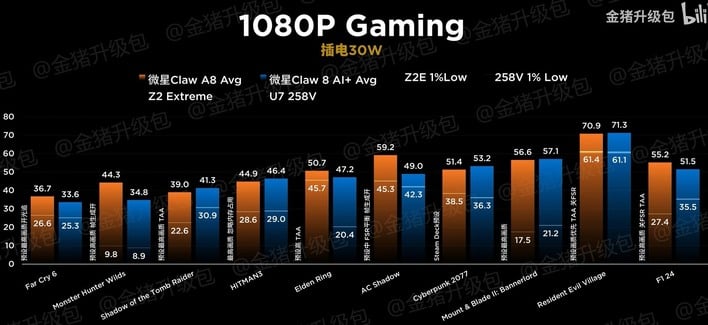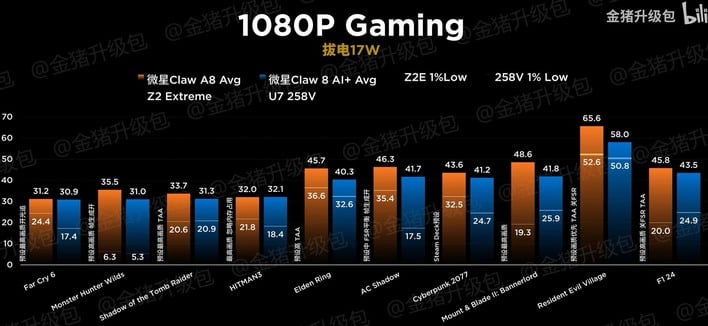Intel Lunar Lake And AMD Ryzen Z2 Extreme Show Surprising Results In Handheld Combat
These benchmarks come by way of the well-known Golden Pig Upgrade Pack on Bilibili. While Mr. Pig is mostly known for his pre-release product leaks, he also publishes videos like the most recent one, titled "Easily surpassing 258V, Ryzen Z2 Extreme test report." Despite his bombastic naming, his own data actually suggests a considerably less decisive advantage over Intel's part.
Testing at a 30W power limit, Golden Pig's data, when collated into a geometric mean, gives us about a 5% advantage for the Ryzen Z2 Extreme, and an even smaller 3% advantage when looking at 1% lows. This is, frankly, margin of error and we don't think it's particularly meaningful. In most games the two chips are neck and neck, although the Ryzen part clearly pulls ahead in Monster Hunter Wilds and Assassin's Creed Shadows—both of which have AMD FSR3 frame generation enabled. Hmm.
Dropping down to a 17W power level, we actually see the gap widen, with a roughly 7% difference between the two parts. 7% still isn't a huge gap, but notably, there are no clear wins for Intel here whereas AMD offers a significant performance advantage in several titles. Both of these chips have eight CPU cores, so it seems like AMD's power management may be just a bit more refined here. Alternatively, it could be because Intel's SoC includes the on-package DRAM in the power limit, yet Golden Pig doesn't seem to have accounted for that difference in the comparison.
In the next graph, which charts performance across a range of power limits for the Z2 Extreme part, we see something very interesting. When testing with all power limits set to the maximum 35W, the reviewer noted a slight performance *regression* going from 30 to 35W. That obviously shouldn't be the case, so he investigated and found that the CPU cores were stealing too much power from the GPU.
He managed to work around this behavior by setting the sPPT (Slow Package Power Tracking) limit and the SPL (Sustained Power Limit) to 30W while raising the fPPT (Fast Package Power Tracking) limit to the maximum value of 48W. This radically improved performance as the chip was 'tricked' into dedicating more of its TDP to the integrated GPU. That's the orange line above.
Meanwhile, the grey line is the result of using those same settings, but using Process Lasso to restrict the game process to the Ryzen Z2 Extreme's five "small" Zen 5C cores. Since the GPU is the bottleneck, the reduced CPU performance doesn't matter much, and even more power gets directed to the GPU. This is particularly helpful at lower power limits, where the Ryzen Z2 Extreme really starts to pull away from the Core Ultra 7 258V. (There are only two data points for the 258V because it does not have such fine-grained power limit control, at least on the Claw 8 AI+.)
This testing challenges the conventional wisdom that these chips are strictly limited by memory bandwidth. If opening up the power floodgates to the GPU can improve performance this way, then clearly either GPU compute or raster performance were holding the game back. Performance results like this are likely why some companies, like Ayaneo and GPD, offer the option to disable CPU turbo on their handhelds. You can check out Golden Pig's video over on Bilibili.
Hat tip to HXL for pointing out Golden Pig's video.





